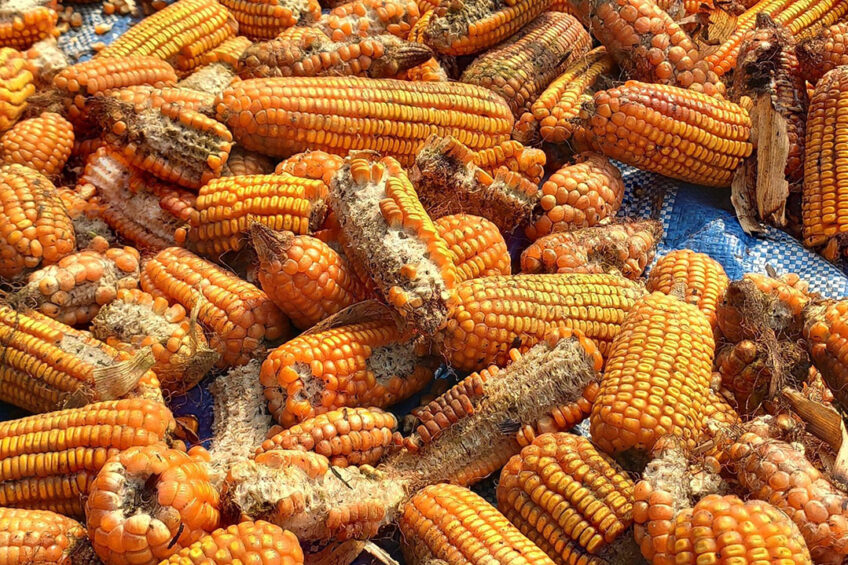Role of climate change in increased mycotoxin levels

Climate change is likely to be part of the reason for the increase in mycotoxin issues for the global animal feed business. And the trend is expected to continue and even accelerate over the next 5 years.
7 out of 10 analyses run last year found raw ingredients contaminated with mycotoxins, according to Cargill’s annual review. But reassuringly, just 35% of these reached performance risk thresholds, showing that positive analyses are not always concerning.
Last year’s study analysed more than 328,000 samples across more than 150 global feed plants, on-farm samplings and storage locations in 54 countries. The majority of these were corn (212,254), cereals (85,478), oilseeds (27,602) or others (3,632). It found 72% of analyses were contaminated with at least one mycotoxin showing that contamination is more likely than not across all ingredients.
Since mycotoxins are produced by moulds as a natural defence response to environmental factors, their occurrence is linked to climate conditions.
Big 4 mycotoxins
The data shows that the “big 4” – Vomitoxin (80%), Fumonisin (78%), Zearalenone (72%) and Aflatoxin (64%) – continue to be the most prevalent mycotoxins across the globe. Ochratoxin and T2 toxin show the lowest contamination rate, with less than 60% contamination occurrence.
Of the 35% that had contamination levels above Cargill performance risk thresholds Vomitoxin (61%), Fumonisin (39%) and Zearalenone (39%) had the highest levels of positive analyses.
Looking at the ingredient crop trends, the report found:
- Corn: 71% of all corn-based ingredients analyses are positive for at least one mycotoxin and 36% are above the risk threshold with Vomitoxin (61%), Fumonisin (45%) and Zearalenone (45%) the most frequently present in corn group analyses
- Cereals: 78% of cereal-based ingredients tested positive with 40% above the risk threshold levels. Vomitoxin was by far the most frequent mycotoxin present
- Oilseeds: A lower rate of 64% were found to be positive with less than a fifth of samples over the risk threshold. In this area, Aflatoxin and Zearalenone were the main culprits along the T2.
We observed an increase in mycotoxin contamination rate over the past 4 years and expect this trend to continue.
Regions with highest mycotoxin prevalence
Clement Soulet, Cargill additives category lead, said regions with the highest mycotoxin prevalence and risk levels last year included China, Asia, North America, Central and South America and Europe, while lower levels were uncovered in Russia and the Middle East.
Commenting on the findings, Dr Soulet said: “We observed an increase in mycotoxin contamination rate over the past 4 years and expect this trend to continue. Since 2018 we have seen a 7% increase in positive analyses above the detection limit.
“The largest prevalence increases since 2018 include Aflatoxin (+11%), Vomitoxin (+6%) and Ochratoxin (+6%). This increase is likely due to various factors including seasonal weather variation, improved technology that enhances our ability to detect contamination, increased by-product use driven by higher commodity prices and changes in agricultural practices, such as crop rotation, less tillage and lower chemical usage. Indeed, less chemical usage, such as fungicides, is a trend. Using fewer fungicides may increase mould rates and therefore, the presence of mycotoxins.”
The role of climate change
He added that climate change was also likely to be playing a part: “Since mycotoxins are produced by moulds as a natural defence response to environmental factors, their occurrence is linked to climate conditions. As a result, changing weather patterns can lead to substantial changes in mycotoxin distribution, frequency and spread. In a changing climate, mycotoxins will contaminate new geographical areas and crops, and we expect this trend to continue and possibly even accelerate over the next 5 years.”
Thomas Pecqueur, Cargill global technology lead for additives, said a targeted and optimised anti-mycotoxin approach was the way forward in feed, in direct response to reported toxin levels, as it was the best way to maximise performance while reducing cost.











